Your Call
Thanks for all the recent comments. Which of today’s three featured intentional blurs is your favorite? All are invited to leave a comment and let us know why they made their choice. With the two skimmer flock blurs, do you prefer the one the the ship, or the one with the clouds?
High Level Question
Considering that the shutter speed and other settings were identical, why is the degree of blurring of the skimmer flock in Image #2 and Image #3 so different?
BIRDS AS ART Office Phone Out!
A tree fell on our phone lines while I was in Deland last week. 863-692-0906 is currently down. If you need to get in touch with BAA, please try my cell at 863-221-2372. If I do not pick up, please shoot us a text. The land line is scheduled to be repaired today.
What’s Up?
I got off the Amtrak Auto Train at 9:18am on Monday morning as we arrived early to Lorton, Virgina. I was in my SUV heading north on I-95 at 9:38am. Hint: pay the small fee to enjoy “first 30 vehicles off.” Maps estimated three hours and 50 minutes for the trip to Long Island. With very few pit stops, but several accidents and more than a few construction delays, the trip actually took me six hours 24 minutes. After 16+ hours on the train and almost seven hours in the car, I was vibrating when I checked into my gorgeous AirBnB in Oceanside. So, as you might guess, I took the afternoon off.
One Tuesday morning, I was at the beach just after 5:00am. With a bad wind from the SW, and some clouds in the east, I decided to go light with just 200-600 and leave both big lenses in the car. The sunrise was OK but absent of big flocks of skimmers. I took a scouting walk, learned a lot about Nickerson this year, and concentrated on making some pleasing blurs. As Walked back west, I was blessed by a huge skimmer blastoff and created a series of images at 1/20 second. I had gotten on the ground a few times and as I headed back to my car I realized that my keys were not in my pockets. Had I dropped them in the sand when I got down on the ground a few times, or had I left them in the car. I was glad that it was the latter, and even gladder that my car was still there and that all of my photo gear was still in the rear of the SUV 🙂
I headed out east to visit my older (surviving) sister Ilene for brunch, and continued on to Dr. Populo, the hand surgeon who saved my badly infected left middle finger years with debridement surgery. I got two injections, one in my right thumb (DeCaurvaine’s Syndrome) and on in my left pointer (trigger) finger. Hint: injections in your hand are quite painful.
I had seen hundreds of fledged and flying young Common Terns in the morning, but with the SW wind, opportunities were few. At one point I was thinking, “I am here for a month and this is bad.” The afternoon session was the polar opposite. There were about 300 small skimmer chicks along the western order of the colony. Again I opted to go with the handheld 200-600 and left the big glass in the car. The south by slightly west wind was ideal as the sun was behind me and the wind coming from somewhat over my right shoulder. I concentrated on skimmer aerial battles and adult skimmer flying with fish. The prey items were mostly sand eels and baby “snapper” Bluefish (Pomatomus saltatrix). I did get one great feeding exchange sequence when a skimmer landed with a small fish and was assaulted by its two voracious chicks.
At about 7:30pm, I noted another photographer sitting well back from the colony ropes. It seemed as if she were pointing her lens at empty sand. I instantly knew exactly what she was up to so I carefully made my way around her to get on sun angle without disturbing her subject and then sat down on the beach just off sun angle. A small, less-than-a-week old skimmer chick continued to walk toward her, and then, toward me. I got some great images of this confused little bird. I have not looked at them on the laptop yet.The chick walked right up to me and scooped out a scrape right next to my left sneaker and rested for a bit. We both sat smiling in amazement. Next, the chick nestled up against the lady’s right sneaker (and then against other body parts!). We were both laughing aloud. We were happy when the baby skimmer made a u-turn and headed back to the colony ropes in search of mom and dad.
Today is Wednesday 13 August 2022. I will be at the beach no later than 5:10am. This blog post took more than two hours to prepare and makes one hundred thirty-two days in a row with a new one.
So far, five folks have been in touch about joining me at either Nickerson or JBWR in the coming weeks. My first In-the-Field client will be joining me on Thursday afternoon. See the details below.
Please remember to use the B&H and Amazon links that are found on most blog pages and to use the BIRDSASART discount code at checkout when purchasing your new gear from Bedfords to get 3% back on your credit card and enjoy free second-day air FedEx. Please, also, consider joining a BAA IPT. You will be amazed at how much you will learn!
|
|
|
Clockwise from the upper left corner back around to the center: Wilson’s Phalarope, JBWR; just fledged Common Tern, Nickerson; Black Skimmer, adult skimming, Nickerson; Black Skimmer killing tiny skimmer chick, Nickerson; American Oystercatcher foraging at sunrise, Nickerson; Common Tern chick swallowing baby bluefish, Nickerson; Short-billed Dowitcher, juvenile, double overhead wing stretch, JBWR; Black Skimmers, predawn flock blur, Nickerson; Black Skimmer, 10-day old chick, Nickerson. Click on the card to view a larger version. Nickerson Beach/East Pond JBWR composite |
Nickerson Beach/East Pond at Jamaica Bay (JBWR) In-the Field Workshops
Both Nickerson Beach and the East Pond at JBWR offer some of the best midsummer bird photography on the planet. Hundreds of pairs or Black Skimmers and Common Terns along with more than a dozen pairs of American Oystercatchers breed at Nickerson each season so there are lots of chicks of all sizes and handsome fledged young to photograph. Provided that the water levels are low, hundreds of young shorebirds in their handsome fresh juvenile plumages stop by the pond each August on their way south.
Nickerson often reveals nature at it rawest, most basic level. Most days we get to photograph all sorts of dramatic behaviors ranging from skimmers and terns fishing and feeding (and tending) their you. There are often chances to shoot a variety of predatory encounters — gulls eating large skimmer chicks, skimmers eating skimmer babies, and Peregrine Falcons hunting. And rarely, if we are lucky, Peregrine Falcons catching! Consider joining me to learn a ton both about bird photography and the birds.
I took the Auto Train north on 31 July and will happily spend all of August on Long Island. I head south on 31 August and should be back home on 1 September (barring anything unforeseen). I am offering In-the-Field sessions at both Nickerson Beach and the East Pond at Jamaica Bay Wildlife Refuge. If you are interested, please get in touch via e-mail or text me at 863-221-2372.
Whether you are a local or would like to fly in for several days of instruction — a sort of private, or small group at worst, IPT, LMK via e-mail so that we can work on a schedule that could possibly include both Nickerson and Jamaica Bay.
The First DeSoto IPT
If you are interested in the first DeSoto IPT, 3 1/2 Days, Tuesday 27 September through the morning session on Friday 30 September 2022, know that I just reserved a three-bedroom AirBnB in Gulfport. Share it for four nights with many multiple IPT veteran Monte Brown and me and save a ton on lodging: $83.69/night/person for a whole home. AirBnB photos available upon request. If interested, shoot me an e-mail.
Follow me on Instagram here. I am trying to feature both new and old images, especially images that have not appeared recently on the blog. Or search for birds_as_art.
BIRDS AS ART Image Optimization Service (BAA IOS)
Send a PayPal for $62.00 to birdsasart@verizon.net or call Jim at 863-692-0906 and put $62.00 on your credit card. Pick one of your best images and upload the raw file using a large file sending service like Hightail or DropBox and then send me the link via e-mail. I will download and save your raw file, evaluate the exposure and sharpness, and optimize the image as if it were my own after converting the raw file in Adobe Camera Raw. Best of all, I will make a screen recording of the entire process and send you a link to the video to download, save and study.
Induro GIT 304L Price Drop
Amazingly, we have two, brand-new-in-the-box Induro GIT 304L tripods in stock. They are $699.00 each (were $799.00) and the price now includes the insured ground shipping to the lower 48 states. Weekday phone orders only: 863-692-0906. Order yours here while they last.
Please Remember
You can find some great photo accessories (and necessities, like surf booties!) on Amazon by clicking on the Stuff tab on the orange/yellow menu bar above. On a related note, it would be extremely helpful if blog-folks who, like me, spend too much money on Amazon, would get in the habit of clicking on the Amazon logo link on the right side of each blog post when they shop online. As you might expect, doing so will not cost you a single penny, but would be appreciated tremendously by yours truly. And doing so works seamlessly with your Amazon Prime account.
Please remember that if an item — a Delkin flash card, or a tripod head — for example, that is available from B&H and/or Bedfords, is also available in the BAA Online Store, it would be great, and greatly appreciated, if you would opt to purchase from us. We will match any price. Please remember also to use my B&H affiliate links or to earn 3% cash back at Bedfords by using the BIRDSASART discount code at checkout for your major gear purchases. Doing either often earns you free guides and/or discounts. And always earns my great appreciation.
Brand-New and As-Good-As-Ever Bedfords BAA Discount Policy
Folks who have fallen in love with Bedfords can now use the BIRDSASART coupon code at checkout to enjoy a post-purchase, 3% off-statement credit (excluding taxes and shipping charges) on orders paid with a credit card. The 3% credit will be refunded to the card you used for your purchase. Be sure, also, to check the box for free shipping to enjoy free Second Day Air Fed-Ex. This offer does not apply to purchases of Classes, Gift Cards, or to any prior purchases.
Money Saving Reminder
Many have learned that if you need a hot photo item that is out of stock at B&H and would like to enjoy getting 3% back on your credit card along with free 2nd Day Air Fed-Ex Air shipping, your best bet is to click here, place an order with Bedfords, and enter the coupon code BIRDSASART at checkout. If an item is out of stock, contact Steve Elkins via e-mail or on his cell phone at (479) 381-2592 (Central time). Be sure to mention the BIRDSASART coupon code and check the box for Free Shipping. That will automatically upgrade to free 2nd Day Air Fed-Ex. Steve has been great at getting folks the hot items that are out of stock at B&H and everywhere else. The waitlists at the big stores can be a year or longer for the hard-to-get items. Steve will surely get you your gear long before that. For the past year, he has been helping BAA Blog folks get their hands on items like the SONY a 1, the SONY 200-600 G OSS lens, the Canon EOS R5, the Canon RF 100-500mm lens, and the Nikon 500mm PF. Steve is personable, helpful, and eager to please.
Important Note
As an Amazon Associate, I earn a small percentage when you purchase from Amazon after using any of the Amazon links on the blog (including the logo-link on the right side of each blog post page). My affiliate link works fine with Amazon Prime and using it will not cost you a single cent. Huge thanks, BTW 🙂
If You Enjoy the Blog …
Please, if you enjoy and learn from the blog, remember to use one of my two affiliate programs when purchasing new gear. Doing so just might make it possible for me to avoid having to try to get a job as a Walmart greeter and will not cost you a single penny more. And if you use Bedfords and remember to enter the BIRDSASART code at checkout, you will (still!) save 3% on every order and enjoy free second-day air shipping. In these crazy times — I lost about fifty thousand dollars in income due to COVID 19 — remembering to use my B&H link or to shop at Bedfords will help me out a ton and be greatly appreciated. Overseas folks who cannot order from the US because of import fees, duties, and taxes, are invited to help out by clicking here to leave a blog thank you gift if they see fit.


Gear Questions and Advice
Too many folks attending BAA IPTs and dozens of photographers whom I see in the field and on BPN, are–out of ignorance–using the wrong gear, especially when it comes to tripods and more especially, tripod heads… Please know that I am always glad to answer your gear questions via e-mail. If you are desperate, you can try me on my cell at 863-221-2372. Please leave a message and shoot me a text if I do not pick up.
|
|
|
This image was created on 2 August 2022 at Nickerson Beach Park, Lido Beach, Long Island, NY. I used the handheld Sony FE 200-600mm f/5.6-6.3 G OSS lens (at 600mm) and The One, the Sony Alpha 1 Mirrorless digital camera. ) The exposure was determined using Zebra technology with Exposure Compensation on the Thumb Dial. Shutter Priority +2.3 stops: AUTO ISO set ISO 250. 1/20 sec. at f/6.3 (wide-open) in Manual Mode. AWB at 6:08:23am on a then cloudy morning. Amazingly, with the exposure set to +2 1/3 stops, RawDigger showed the exposure to be almost one stop too dark. Tracking: Zone AF-C with Bird Face/Eye Detection performed perfectly. The operator, however, needed to pan faster 🙂 Be sure to click on the image to enjoy a high-res version. Image #1: Molting adult breeding plumage Sanderling flight blur
|
Pan Faster Dummy!
The best way to improve your flight photography? Pan faster. I have been giving that advice for three decades but still do not have it down pat. But, shorebirds are fast, erratic fliers and I was glad to get the whole bird in the frame. With it too far to the left, I added a smidgeon of canvas on the left and cropped to a square. I darkened the face and eye and added the forehead. The front portion of a bird’s face are often lost due to a phenomenon that I named pixel blurring — the forward part of the head will often blend with the sky and become misshapen and too light.
|
|
|
This image was also created on 2 August 2022 at Nickerson Beach Park, Lido Beach, Long Island, NY. Again, I used the handheld Sony FE 200-600mm f/5.6-6.3 G OSS lens (at 600mm) and The One, the Sony Alpha 1 Mirrorless digital camera. ) The exposure was determined using Zebra technology with Exposure Compensation on the Thumb Dial. Shutter Priority +2 stops: AUTO ISO set ISO 100. 1/20 sec. at f/7.1 (stopped down 1/3 stop) in Manual Mode. AWB at 6:26:48am on a then cloudy morning. Amazingly, with the exposure set to +2 stops, RawDigger showed the exposure to be almost one stop too dark. Live and learn. Tracking: Zone AF-C with Bird Face/Eye Detection performed perfectly. The operator, however, needed to pan faster 🙂 Be sure to click on the image to enjoy a high-res version. Image #2: Black Skimmer flock blur with large ship on the horizon
|
Getting Lucky
There was really not much going on until every skimmer in the colony blasted off and flew out over the ocean sometimes coalescing, and sometimes splitting into two or three groups. I was in a great spot, and the 200-600 was the perfect lens for the job at I was able to frame each burst. When doing blurs, the relatively small aperture ( f/6.3) is not a factor at all as AUTO ISO was setting very low ISOs (because of the slow shutter speeds.)
|
|
|
This image was also created on 2 August 2022 at Nickerson Beach Park, Lido Beach, Long Island, NY. Three seconds after Image #2 was created. Again, I used the handheld Sony FE 200-600mm f/5.6-6.3 G OSS lens (at2980mm) and The One, the Sony Alpha 1 Mirrorless digital camera. ) The exposure was determined using Zebra technology with Exposure Compensation on the Thumb Dial. Shutter Priority +2 stops: AUTO ISO set ISO 100. 1/20 sec. at f/7.1 (stopped down 1/3 stop) in Manual Mode. AWB at 6:26:48am on a then cloudy morning. Amazingly, with the exposure set to +2 stops, RawDigger showed the exposure to be almost one stop too dark. Live and learn. Tracking: Zone AF-C with Bird Face/Eye Detection performed perfectly. Be sure to click on the image to enjoy a high-res version. Image #3: Black Skimmer flock more blurred with clouds
|
Why Blurs in the First Place?
In photography, necessity is often the mother of invention. To create sharp images in ultra-low light situations would require extremely high ISOs, often greater than ISO 12800. By trying to create some pleasing blurs you have the chance to do something extremely creative and often pleasing. Pleasing blurs that are done well have historically been oft-honored in prestigious photographic competitions. If you hate all blurs, I am fine with that. I, on the other hand, love them, enjoy creating them, and work hard to make a few nice ones. Remember that pleasing blurs are not accidents.
|
|
A Guide to Pleasing Blurs
Learn everything there is to know about creating pleasingly blurred images in A Guide to Pleasing Blurs by Denise Ippolito and yours truly. This 20,585 word, 271 page PDF is illustrated with 144 different, exciting, and artistic images. The guide covers the basics of creating pleasingly blurred images, the factors that influence the degree of blurring, the use of filters in creating pleasing blurs, and a great variety of both in-the-field and Photoshop techniques that can be used to create pleasingly blurred images.
Artie and Denise teach you many different ways to move your lens during the exposure to create a variety of pleasingly blurred images of flowers and trees and water and landscapes. They will teach you to recognize situations where subject movement can be used to your advantage to create pan blurs, wind blurs, and moving water blurs. They will teach you to create zoom-blurs both in the field and during post-processing. Artie shares the techniques that he has used and developed for making blurred images of flocks of geese in flight at his (formerly) beloved Bosque del Apache and Denise shares her flower blur magic as well as a variety of creative Photoshop techniques that she has developed.
With the advent of digital capture creating blurred images has become a great and inexpensive way to go out with your camera and have fun, especially when there is not much light. And while many folks think that making successful blurred images is the result of being a sloppy photographer, nothing could be further from the truth. In “A Guide to Pleasing Blurs” Artie and Denise will help you to unleash your creative self.
Typos
With all blog posts, feel free to e-mail or to leave a comment regarding any typos or errors.

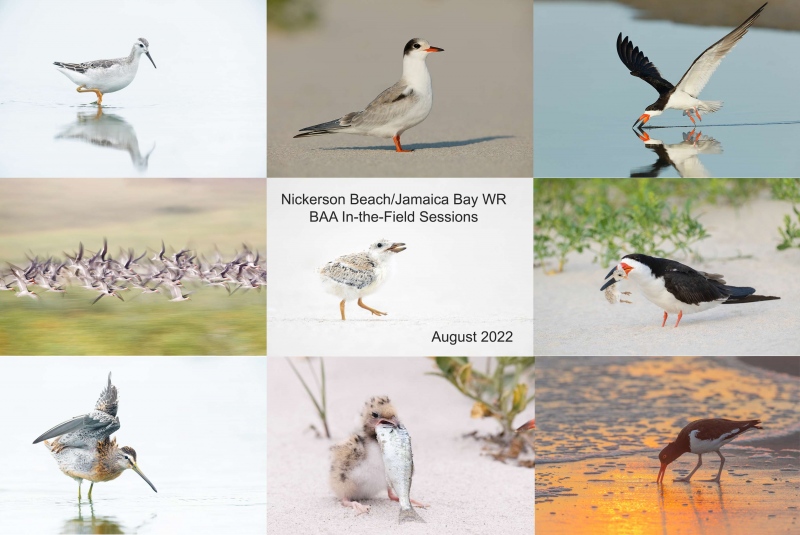

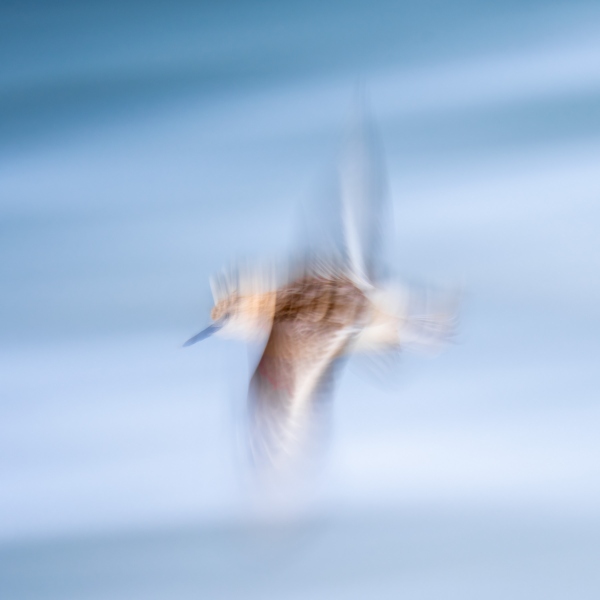
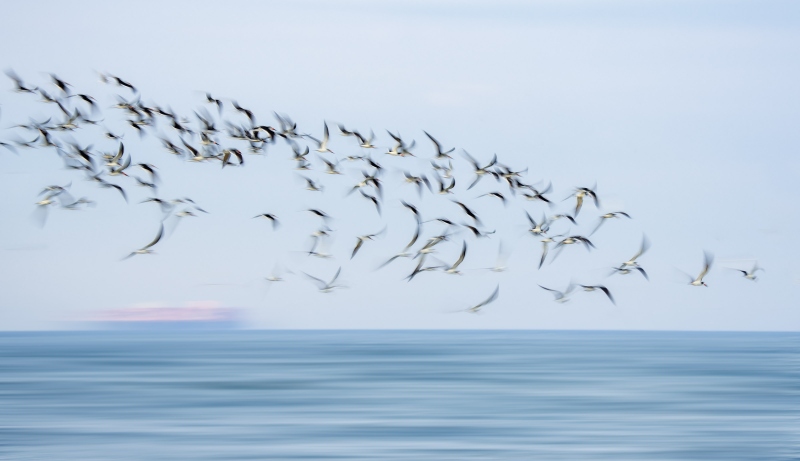
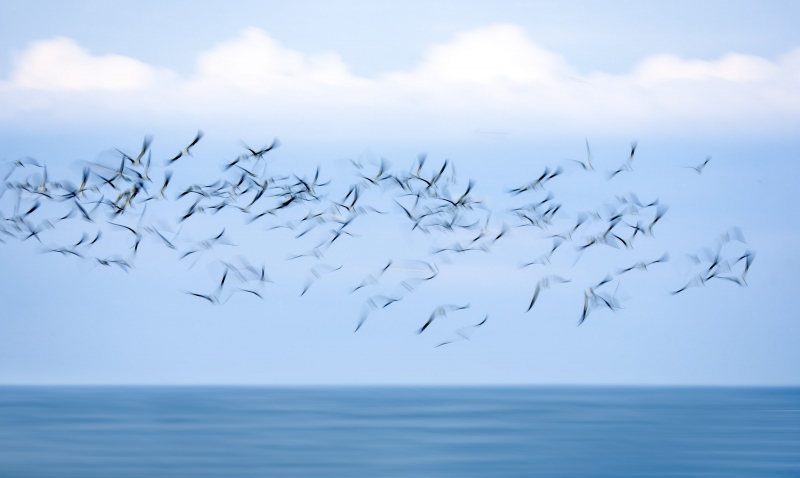
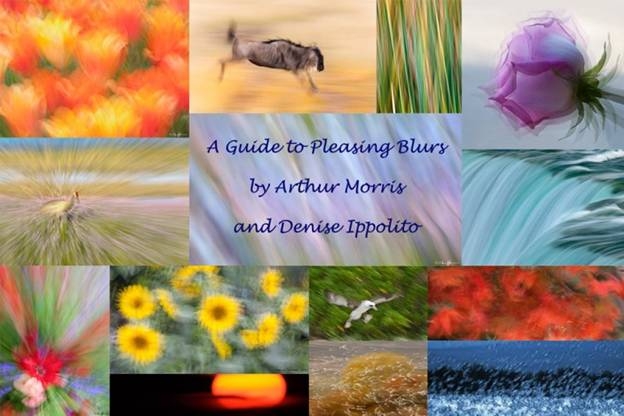













Birds heading towards or away from the camera, versus across the frame, would account for a difference in motion blur.
In response Artie, I never doubted the value of your IPTs. Just a lot of money going out this year, but I’m not complaining as it’s primarily photography related. I will definitely see you out there in the field, sooner rather than later.
My pick is #1. I like the wing movements. For the other question I think it is due to the Panning.
Hi Milinda, You are on the right track on the other question. What about the panning accounts for the difference in the degree of blurring?
with love, artie
The framing of the flock images is exceptional. The shape of the flock and the framing of the ship in that space makes that one the winner for me. The sea looks “smoother” in the second flock blur. Were you panning faster in that one?
Thanks, Neil. I cheated on the ocean in each image by applying Motion Blur in Photoshop only to the water. That technique is detailed in “A Guide to Pleasing Blurs.”
with love, artie
Typo: I did got one great feeding exchange
Thanks and fixed with love. I got it 🙂
a
I’ll go with #1 here as I like the isolated subject and the painterly background.
As for the blur difference…the birds in #3 are closer so they’ll blur more due to an apparent higher speed. Think of a plane doing 500mph from miles away…looks slow. Now put that plane 100 yards in front of you. Zoom zoom.
Thanks, David, I love that one too. Everything that you said above is 100% correct — I have been teaching that principle to folks for several decades. But the distance to the subject in the first flock blur image was 176.19 meters and the distance to the second one was 181.27meters. For all intents and purposes, those are the same. So — and this represents a great opportunity for you and for others, what caused the drastic difference in the degree of blurring in those two images???
with love, artie
Focal length.
Not focal length at all.
with love, artie
My preference is for no. 1 as the full range of wing movements are visible in the photo.
Artie, Thanks for all your work on the blog; I binge read last night. I’d keep going right now, but instead I’ll go to work so I can afford one of your IPTs.
Thanks. I like them all but I love shorebirds. And thanks for your comments on the various blog posts — there is a lot to learn.
Good idea on getting to work. The IPTs are expensive because you will learn more than on any other photo trips. Do know that my rates for In-the-Field sessions are lower/day or session when compared to the IPTs, that to attract new folks and get them to learn how much they are missing. In fact, my In-the-Field rates for Sebastian are actually lower than those of the guy you mentioned in your e-mail.
with love, artie